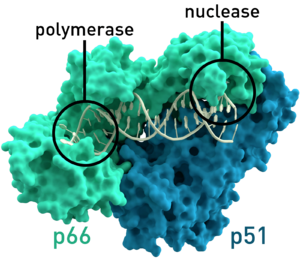Reverse transcriptase facts for kids


A reverse transcriptase is a special kind of enzyme that does something a bit unusual in biology. Normally, living things make RNA from DNA. This process is called transcription. But a reverse transcriptase enzyme works the other way around: it builds DNA using an RNA template. It's like writing a message backwards!
This enzyme first makes a single strand of DNA from a single strand of RNA. Then, it can even make a second DNA strand that matches the first new DNA strand.
Some well-known reverse transcriptases include:
- The one from the human immunodeficiency virus (HIV-1 reverse transcriptase) (PDB 1HMV).
- The one from the murine leukemia virus (M-MLV reverse transcriptase).
- The one from the avian myeloblastosis virus (AMV reverse transcriptase).
- Telomerase reverse transcriptase, which helps protect the ends of chromosomes in eukaryotic cells.
How Reverse Transcriptase Was Found
Reverse transcriptase was discovered by Howard Temin at the University of Wisconsin–Madison. He found it in a virus that causes cancer. At the same time, in 1970, David Baltimore also found this enzyme independently at MIT. He found it in two other RNA viruses that cause tumors.
For their important discoveries, Temin and Baltimore shared the 1975 Nobel Prize in Physiology or Medicine with Renato Dulbecco.
A Big Idea Changes Science
At first, the idea of reverse transcription was not very popular. It went against the "central dogma of molecular biology". This main idea in biology said that genetic information always flows from DNA to RNA, and then from RNA to proteins. It didn't allow for RNA to make DNA.
However, when Howard Temin and David Baltimore both found the enzyme that could do reverse transcription in 1970, scientists had to accept this new possibility. It showed that genetic information could indeed be passed on in this "reverse" way.
This discovery led to new ideas about how life might have started. Some scientists now think that the first genomes (all the genetic material of an organism) might have been made of RNA genes. The RNA genes we see today could be what's left from that early time. Reverse transcriptase might be a leftover from a time when DNA genes were made by copying RNA genes. This theory is important for understanding the very first stages of evolution on Earth.
Reverse transcription is also used by tiny moving pieces of DNA called transposons.
Images for kids
-
Reverse transcriptase is shown with its finger, palm, and thumb regions. The important amino acids for its work are shown.
See also
 In Spanish: Transcriptasa inversa para niños
In Spanish: Transcriptasa inversa para niños


